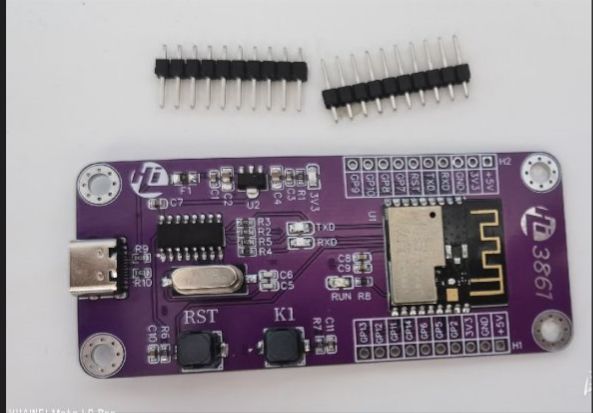 Completed
CompletedHi3861 Minimum system board
PRO Hi3861 Minimum system board
Hi3861 Minimum system board
License
:GPL 3.0
Description
Main control features
The Hi3861 IoT WiFi module is a system-in-package module based on HiSilicon's Hi3861LV100 chip, which provides complete Wi-Fi IoT development functions. The module has integrated peripheral components such as crystal oscillator, filter capacitor, and WiFi antenna, and only needs 3.3V power supply to work normally. The Hi3861 IoT WiFi module can greatly improve the efficiency of development and control, and reduce the complexity of the supply chain.
Features:
Operating Voltage: 5V (USB Power Supply)
Core chip: Hi3861.
Extended interfaces: All GPIO ports are exported.
Functions: Internet access, Internet of Things, SDK development.
Steps:
Schematic design, PCB proofing, component selection, board soldering, debugging.
Schematic Design Description:
1. Schematic diagram of the smallest system.

VCC 3.3V power supply with 100nf and 10uf filter capacitors.
EN pin pulled, chip enabled.
SW1 is the reset button, pull down the chip to restart.
2. Power supply interface: Micro-B and TYPE-C are adopted, which is more convenient for the use of data cables. A USB to serial port is added to facilitate program simulation. A self-recovery fuse is added to protect the USB port.

3. Program download circuit: ch340G is used, and an external crystal oscillator clock circuit is required. Why not use anything else, my principle is what to use in my hand, and I happen to have more than 20 CH340G in my hand.

4. Voltage regulator circuit: originally planned to design DC-DC voltage regulation, and finally chose linear voltage regulator (LDO) considering the cost.

5.Button circuit: RST button on the left, servo control button on the right, pull-up resistor and filter capacitor are added.

PCB Design Instructions
Tips: Hi3861 antenna does not need to be poured copper, DRC errors can be ignored, and physical verification has been made.
Physical display description


Precautions
Pay attention to distinguish the direction of CH340N, there are not many other requirements, welding technology depends on the individual! The difficulty of the board should be TYPE-C welding.
After the welding is completed, use a multimeter to confirm that there is no short circuit in the power-on test.
Designed by guangwei.Su (from OSHWHub)
Link:https://oshwhub.com/suxuezhang/hi3861-zui-xiao-xi-tong-ban-_2022-10-16_22-43-55
Design Drawing
 The preview image was not generated, please save it again in the editor.
The preview image was not generated, please save it again in the editor. Empty
Empty


Comment